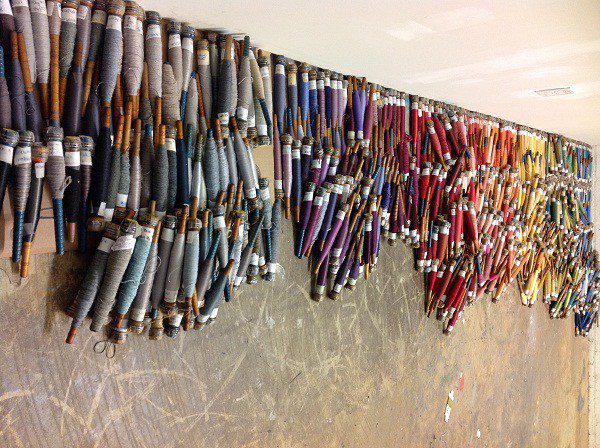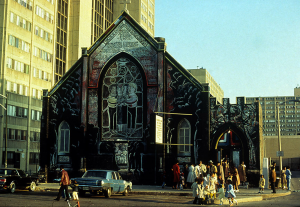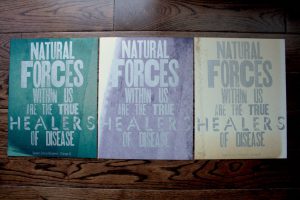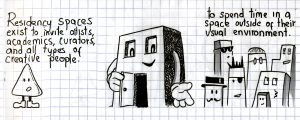After Rita Grendze invited me to pair up with her for a collaborative residency at Water Street Studios in Batavia this summer, I was eager to accept. We both make non-permanent installations, and as we were sorting through thousands of bobbins of thread for a project that will be unveiled next year. I collected some of her thoughts about making, marketing, and enjoying ephemeral art.
Experiencing the Moment
Everyone has life changing experiences. Whether it’s something planned, like a wedding or having a baby. Or something unplanned, like you go for a walk and turn the corner and see something absolutely amazing in nature. Whether it’s a group of blue heron where you weren’t expecting them or a fox crossing your trail when you’re out for a run. That moment it burned into your brain and I think with most great art, it’s not about the object and the possession. It’s more that people have the experience of seeing the art.
What happens with ephemeral art is that it starts to take on closer relationship to something like theatre or music. Even as the same performer does the same exact soliloquy five nights in a row, every night will be different. That’s what’s gonna keep people coming back. I still have the parts to a big book piece I made in Michigan. I’m still using it as materials. I’m still exploring those ideas but it will never be the same piece twice, even if I use the same exact materials. It would be reacting to the space, reacting to the amount of material I have to the temperature in the space, things that would effect it. and whoever would come see it would react to it differently because it’s altered just slightly and if they’ve seen it before they’d carry that memory with them that will color the way they view it again.

That’s how we live in the world. Our whole experience of life is tainted through our memories and the experiences we’re having. I think there’s a preciousness in that that balances out the lack of preciousness in my materials. I don’t work in cast bronze. I work in cast off books or bobbins of thread that people have given us. Which I find really beautiful and is very socially relevant to where we are in this country, at this time. I find that very precious and to capture that somehow is really important to me, because it may not be relevant tomorrow. It may not be relevant in a month.
I’m not a philosopher, I’m not a historian. I’m not an archivist. I’m right here, right now and I’d like other people to be here with me to experience this with me. I think there’s a huge value in that. In making the connection with both the people and the stuff. Often it‘s so fleeting, it’s seconds, it’s nanoseconds. It’s so tiny that it’s gone but to me that’s just fantastic that it happens at all.
Impermanence
I think it’s hard for a lot of people because they don’t understand the impetus behind making something that won’t last. People don’t understand that you do something because you want to do it. People make the art that they want to make but then if they’re painting, they have something that stays and can be sold as a product or a commodity. People who work in ephemeral art often don’t have that. They have the experience.

It used to bother me that my work was not more permanent or archival. What might be ironic is that I studied fiber in undergrad and graduate school and there were people making installations but I was making more sculpture. I felt like I needed to do something to make them stronger and more permanent so I learned how to weld, and immediately upon learning how to weld, I started doing impermanent work.
Usually if do an installation type piece, it’s up for at least a month and I’m been able to go back, at least once or twice, when it’s up. Not as the artist but just go back as someone viewing it. To kind of anonymously go back and see it, which is a really great way to see your own work. If you have a little bit of time to get over the process of making, installing and doing all that physical labor, and a little more time to emotionally deal with it, then it’s okay. You need that physical time away from it and with it so that you can come to terms with it not being permanent.
Ephemeral Art Market

People have asked me often, “who’s going to buy your art?” Nobody, but someone might fund it because they want to have people they know to have that experience. I’ve tried at different times to make some souvenirs and what’s worked best for me is documenting it and then either putting it on my website or making a publication of sorts out of it, but making a physical souvenir has always felt a bit false. My hope is to keep making enough work and interesting enough work and documenting it well enough that that I get a chance to make more of it.
It depends on where it fits in their programing; where it fits in their aesthetic and their community at large. Every gallery is in a slightly different community and they have a different audience, hopefully. I think a smart curator just shows work that they love, that they can somehow sell to an audience to get the audience to come back to their place. A smart curator will keep challenging the audience just enough to make them have questions but not so much that it alienates them. Out of those five shows that I visit there every year, maybe at one of those shows I will buy a piece.

It’s about cultivating a long term relationship and hopefully sometimes having art that’s more of an experience will also cultivate a different kind of relationship. Give that potential art supporter or viewer a different kind of experience. And I think a lot of galleries, contrary to popular belief that they make money selling the art. A lot of them have other resources because with the way the economy’s been the last few years I don’t think a lot of people are selling that much art.
A lot of the places I’ve been showing are small kind of community art centers or museums. They aren’t really worried about selling work but they are worried about funding, so if someone comes to see a piece and it really engages them with questions about literacy and the permanence of books and they happen to have money they might made a donation to that organization.
About collaboration and social capital
As an artist that so often works alone, getting a chance to work with other people, either through collaboration or having community support of a work is pretty empowering. Especially if you have to make thousands and thousands of something, having someone come in and make a hundred. It gets you through the next 900.

One of the beautiful things that happened with one of my earlier pieces was that it had these paper discs that people could take with them, so I wanted lots of them. I bought all these paper punches and left them outside my studio and said “anyone that wants to can take a paper punch and a stack of magazines and books and punch out any holes they want.” I had images of one woman who took them home for Thanksgiving and her mom, and her dad and her sister are all punching holes out.
That speaks about community and engaging and people wanting to feel like they belong. It allows the viewer another way to enter and feel like the art isn’t somewhere different than the world they inhabit. They can get an idea of how much labor was involved in making the art. Maybe it brings the art down to their level or brings them up to the art’s level but it’s that meeting point. It’s not the only point for people to interact with the art but it’s a pretty powerful one.
The future of ephemeral art
I don’t know where it’s gonna go. We’re living it. I think we’re running out of room for permanent things. I think museums are running out of room. They’re going to have to be very selective of what they keep in their collections. Look at the way we’re storing our records of art too. We used to all have boxes and boxes of slides and you can talk about archival quality paper but now so much of it is digital.

I don’t want to saddle my kids with a lot of stuff. I think people have been saddling future generations with stuff for a long time. We’re becoming more and more aware of how finite our world is and our storage capacity. And because of that I think we’re starting to have a problem with our emotional and mental storage capacity as well. I mean how much more can we take? We have Rodin, we have Michelangelo. Maybe there’s not room for someone else with that much stuff.
I’m more interested in legacy than in permanence. What will they be remembered for? We were just looking at a Rodin casting when I was in Milwaukee a couple of days ago. I mean, it’s beautiful, it’s amazing, it’s powerful, I’m so glad that it’s here for me to see it. Two galleries over there is a Tara Donovan piece made out of clear buttons. Which is also beautiful in different ways. The Donovan piece, I would venture is probably less permanent than the Rodin piece, however it’s make out of plastic which doesn’t really break down very well either.
About this collaboration
What I love about our residency at Water Street Studios is I’m a fiber background and I love lots of material and you work with string. We both work in installation and in this ephemeral material and I’m really pleased that so much of this just kind of fell into place, that it wasn’t forced. Not like it was my project or your project but it really has become our project because we came to it at the same time. I didn’t have a preconceived idea of what we would do. I just thought that we’d do something cool.

There’s a lot of room for it to change. We have to do a couple things to get it ready so we can put up and then react very directly to the space. I’m pleased that what we’re doing is to really taking advantage of the nature of the material, which is thread on a wood bobbin. Bobbins have a lot of mass to them. And the thread itself seems light but they’re quite heavy. It’s all different kinds of thread, some are wool, some are other materials.
We worked separately. We worked at the same time, really celebrating the abundance of the materials and the color because the color has become so important to the way that we’ve treated it. The way we handle the material with these spools of these vibrant reds and blues and greens, and then these really soft whites that actually end up being yellow and brown and all kinds of other colors. For me, this is fantastic because I don’t really use a lot of color. Color’s always really intimidated me and I’m just loving it. I’m finding that I’m looking at things differently, I’ve been looking at pairing of colors differently.
 Diana Gabriel is an artist and curator with a soft spot for artisans and an inclination toward all linear things, patterns, and simultaneity. Diana is primarily a painter but supplements this practice with large site-specific installations. She emigrated from Bogota, Colombia at a young age and quickly emerged herself in the Fine Arts. She earned her BFA from Northern Illinois University in 2004 and her MFA from Illinois State University in 2007.
Diana Gabriel is an artist and curator with a soft spot for artisans and an inclination toward all linear things, patterns, and simultaneity. Diana is primarily a painter but supplements this practice with large site-specific installations. She emigrated from Bogota, Colombia at a young age and quickly emerged herself in the Fine Arts. She earned her BFA from Northern Illinois University in 2004 and her MFA from Illinois State University in 2007.



